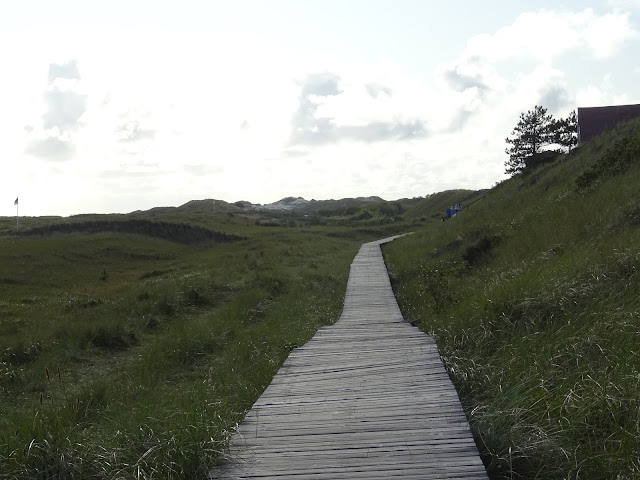I would not have thought that I would be there again so soon after my last trip to the north of Germany (--> Link). But who explores the Baltic Sea has to discover the North Sea as well! And so it happened that I had the chance to spend a great weekend at the North Sea recently. Here is my travelogue.
It's relatively easy to get to the North Sea. By train or plane to Hamburg, then from there by rental car. After not even 2 hours drive we already reached Sankt Peter-Ording, the sand paradise of the North Sea. Where else do you find a 12 km long sandy beach in Germany? The city is quite big and has grown together from 4 districts. Everywhere there are small shops and restaurants, it is nice to stroll around. And: Perfect to find shelter when it rains like cats and dogs. We quickly learned that this happens quite often here and that its a good idea to have your raicoat ready all the time.
We explored the surrounding area with our rental car and visited the lighthouse of Westernheversand, known mainly as a "model" for the Jever beer advertising. We did a nice walk and observed the high tide slowly coming in. Quite a fascinating scene - and also a bit scary! We've been told it's better to head back as soon as the tide comes in. Otherwise it could be quite dangerous.
 |
| The tide coming in. One hour later, the grassland will be under water. |
 |
| Lighthouse Westerheversand |
After the walk we returned to Sankt Peter-Ording and wanted to have a drink at the nice restaurant built on pile dwellings. But we had underestimated the tide - or how would you manage to get to the restaurant on the photo below? :-)
Compared to the Baltic Sea, the North Sea is much rougher. Wind, rain and sun alternate almost every minute. In this rhythm you also change your clothes - jacket on, jacket off, sweater off, sweater on. Here you feel very close to nature and experience the tides up close. I was very fascinated!
 |
| The "Mary Poppins experiment" |
At the North Sea, one absolutely must undertake a mudflat hike. According to my travel guide, the mud flat is defined as the transitional area from the solid land to the sea that is overflowed at high tide and "dries" at low tide. You can imagine that this change creates a fascinating ecosystem with millions of creatures like crabs, snails and worms.
A mudflat hike is an exciting experience, but it is absolutely essential to follow the instructions on site. Nobody wants to be swallowed by the mudflats!
If you're very interested it's a good idea to do a guided tour which are offered on site.
Fortunately we still had time to explore the surrounding islands. All right, only 2 of them. But this is a beginning, isn't it? Instead of visiting the most popular island of all - Sylt - we decided for 2 smaller ones: Hooge and Amrum. With a ferry, which left at Nordstrand, we reached the 2 islands problem-free and quite comfortably.
At Hooge we found (besides rain, wind, sun and rainbows as always) sheep, green meadows and beautiful reed houses. There was not much going on, the more we enjoyed the green idyll in the middle of the sea. We rented a tandem and curled around the island.
The second island was Amrum, a bit bigger and more touristy than Hooge. But also this one was wonderfully green and wide.
The ferry took us back to Nordstrand and we arrived there when the sun slowly disappeared on the horizon. But it was just enough to reach the wonderful city of Husum. We had never expected to meet such a picturesque city - the small harbour, the beautiful houses and the relaxed evening atmosphere inspired us!
Unfortunately we already had to go home the next day. Too bad! We would have loved to stay even longer, there would have been so much to discover!
On the way home we stopped at the Eider Barrage (Eidersperrwerke) near Tönning, Germany’s largest coastal protection structure with the purpose of protecting the surroundings from storm surges by the North Seas. Quite an impressive construction!
Oh, and not to forget: Look what we finally found!
 |
| Finally! A seal! |
We had the chance to do another pitstop - which was really worth it! In Brunsbüttel, it is possible to visit the locks of the "Kiel Canal" (german Nord-Ostsee-Kanal, NOK). If you are as fascinated by seafaring as I am, this is the ideal place to sit down and do "shipwatching". This canal that connects the Baltic with the North sea was opened in 1895, is 95 kilometers long and is passed by about 30 thousand ships per year (not counting all the sport boats and sailing ships) - more than the Panama or Suez canal.
If you have time, make sure you do a guided tour here. Our tour with a very experienced guide was very interesting!
After a while of "ship spotting" I would like to go home with the cargo ship. Was of course not possible. But gave me good ideas for further trips! :-)
The North Sea is really worth a trip. Even if the Baltic Sea is a little more "lovely", the North Sea has its own charm. The harsh weather and the changing tides on the one hand, wonderful idyllic landscapes, small islands and sweet houses on the other hand - who likes extreme contrasts and rubber boots will love it here!































